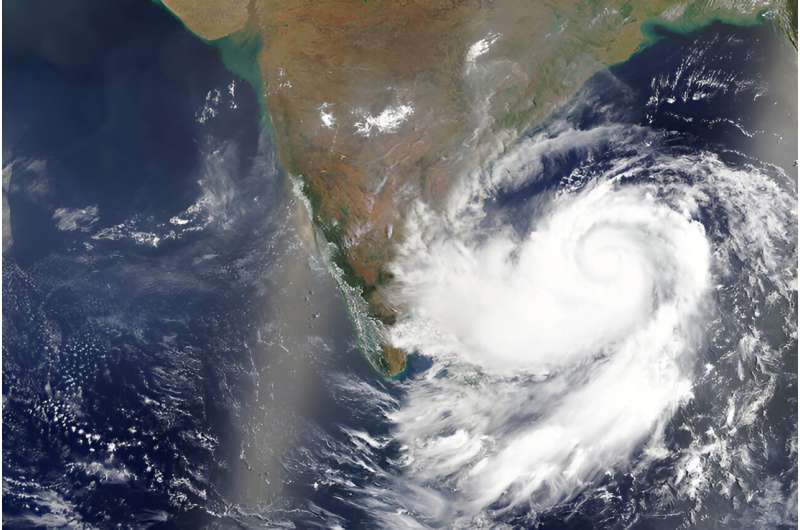This article has been reviewed according to Science X's editorial process and policies. Editors have highlighted the following attributes while ensuring the content's credibility:
fact-checked
peer-reviewed publication
trusted source
proofread
Study shows a decrease in Indian Ocean cyclones

While the threat of tropical cyclones increases around the world, a new study published in Nature Communications shows one area experienced a significant decline in cyclone activity. But, with recent changes in climatic patterns in the Pacific, the number of cyclones is expected to increase in the coming decades.
The paper, "Pacific Decadal Oscillation Causes Fewer Near-Equatorial Cyclones in the North Indian Ocean," is co-authored by Pallav Ray, associate professor in meteorology at Florida Tech, along with researchers from New York University Abu Dhabi, McGill University, Abu Dhabi Polytechnic, University of California San Diego, India Meteorological Department, Pacific Northwest National Laboratory, Cochin University of Science and Technology and the Ministry of Earth Sciences (India).
The findings showed a 43% decline in the number of low latitude (originating between 5–11 degrees) cyclone formations from 1981–2010 in the north Indian Ocean compared to the number of formations between 1951–1980. The decline is primarily due to the weakened low-level vorticity modulated by the Pacific Decadal Oscillation (PDO) and the increased vertical wind shear. The PDO is a long-term fluctuation in sea surface temperature of the north Pacific Ocean. The PDO waxes and wanes approximately every 20 to 30 years, going through "cool" and "warm" phases.
Tropical cyclones do not form easily near the equator but can intensify rapidly. The wind pattern in the Indian Ocean helps initiate the cyclone spin near the equator. Without the storm-weakening wind shear, storms can move and strengthen more easily. This research can help communities in the path of these rapidly intensifying storms better understand how to be prepared for them.
"I hope that this paper will bring a lot more interest in these types of storms," Ray said. "One of the reasons why these types of storms have not received much attention is because most cyclone researchers work on the Atlantic and such storms are very rare there."
The paper was inspired by Cyclone Okchi, a 2017 storm that formed near the equator, passed through Sri Lanka and India, and killed 884 people. That was the first time that Ray, a native of India, and the researchers on the paper came to realize there were so many storms that originated close to the equator. That led to them looking into the numbers and discovering the decline in cyclonic activity near that area.
In the presence of warming along the equator and a favorable phase of the PDO, both the intensity and frequency of such cyclones are expected to increase. The paper notes the changes in tropical cyclonic activity due to natural variability and climate change call for appropriate planning and mitigation strategies.
"There has been a decline close to the equator, but there has been an increase at the same time away from the equator, in the Indian Ocean," Ray said. "Overall, there is a decline definitely, but the decline is not this high, because there was an increase away from the equator."
Ray has done previous research on cyclonic formation, publishing a paper last year on the El Niño-Southern Oscillation, the climate pattern involving warming or cooling sea surface temperatures in the Pacific, and its influence on the formation of tropical cyclones in the Indian Ocean.
The study showed that in the Bay of Bengal, that influence is geographically confined, a discovery that should help extend the lead time of seasonal predictions for cyclones that form in that region.
More information: Shinto Roose et al, Pacific decadal oscillation causes fewer near-equatorial cyclones in the North Indian Ocean, Nature Communications (2023). DOI: 10.1038/s41467-023-40642-x
Journal information: Nature Communications
Provided by Florida Institute of Technology




















